Penobscot paddler sees potential in river restoration
Scott Phillips, owner of Northeast Outdoor Sports in Old Town, readily acknowledges paddling a canoe is in his blood. One of his oldest memories is fishing in Roxbury Pond near Andover when he was 4, sitting in an Old Town canoe with his father, Butch Phillips, now a Penobscot tribal elder.
An eight-time national whitewater champion, Phillips makes his living as a sales representative for Old Town Canoes & Kayaks, Johnson Outdoors and several other vendors of paddling and outdoor accessories. A decade or so ago, he helped build the first birch-bark canoe made on Indian Island in half a century. The experience of paddling that canoe 100 miles up the Penobscot River from Indian Island to Katahdin with his father, he says, still gives him goose bumps when he thinks about it.
He spoke recently with Mainebiz about the Penobscot River Restoration Project, which has been hailed nationally as a model of collaboration for the way it has balanced environmental and economic interests — removing two dams to open access to 1,000 miles of habitat for Atlantic salmon and other native sea-run fish while at the same time allowing the owner of the remaining dams to increase their generating capacity.
Not surprisingly, Phillips sees greater opportunities for recreational paddling and fishing along the river as a benefit of a free-flowing and healthier river. He only has to look to Augusta's experience since the 1999 removal of the Edwards Dam on the Kennebec River, which, like the Veazie, was the first barrier encountered by fish seeking spawning grounds upriver. A 2008 study by Bates College environmental economist Lynne Lewis calculated how much anglers spent on transportation, food, lodging and guide fees and estimated the annual economic impact from improved sport-fishing at $27.6 million, versus $8.3 million before the Edwards Dam's removal.
The following is an edited transcript of the interview.
Mainebiz: As a member of the Penobscot Nation, as well as someone who enjoys paddling, what were your thoughts on the July 22 breaching of the Veazie Dam and last year's demolition of the Great Works Dam a few miles upriver?
Scott Phillips: Well, of course I'm looking forward to the day when we get to paddle [more of] the river again. But watching those dams get breached, for me, was more about bringing back the health of the river. Get the dams out of there and let the water flow through, and let the fish that have been stymied for so long come back to the spawning grounds. That's going to improve the overall health of the river.
For some of these species of fish, the number of spawn will be in the millions — or even billions. It's not only going to help perpetuate those species of fish in this watershed, but other fish are going to forage on them as well. And that's going to benefit the birds and wildlife throughout the whole watershed. It's just going to explode.
MB: As I understand it, Veazie has been the first obstacle those fish would encounter as they swim upstream from the sea to their native spawning grounds in the Penobscot River. How long has that been a barrier?
SP: In various forms, it's 180 years. It's been a long time.
MB: This demolition and the earlier tearing down of Great Works is the result of a lot of years of negotiations among the various stakeholders, including the Penobscot Nation, with some give-and-take on all sides. Did you have any role in that process?
SP: No. I wasn't involved in the negotiations that led to the agreement. But since this agreement was made public in 2004, I've been one of 15 'ambassadors' for the Penobscot River Restoration Project. My focus is more involved with recreation. There are plenty of people who can talk about the fisheries and hydropower and the tribal perspective, but because I'm in the paddle-sports business and I'm a paddler and a fisherman, they kind of looked to me to convey the recreational aspects.
Before I started Northeast Outdoor Sports, I worked for Old Town Canoes for 14 years. I worked in sales and marketing and I traveled all over the country, doing sales clinics and visiting dealers and seeing a lot of different paddling operations. I've raced around most of the East Coast of the United States.
So that's given me a lot of perspective on what can be done recreationally on the river now and into the future.
MB: What are some of the recreational opportunities that become possible once Veazie Dam fully comes down sometime next year?
SP: I guess the best way I can explain that is to tell you what it was like before the dams came out.
This section of river has been very underutilized with the dams in there. I've only paddled it once in my life … it was probably 10 or 12 years ago. There was some whitewater in it, but there was a lot of flat water behind the dams, and the portages around the dams were not easy. For just a person jumping into their canoe two years ago, to paddle from Old Town to Bangor, they had two very difficult obstacles to get around.
So, one recreational opportunity might be as simple as somebody guiding a person from Old Town to Bangor — because there are certainly some people who can't navigate whitewater on their own. If you're a person who's not confident about being able to handle it, then you can hire a guide to take you down the river.
Or maybe it's in a raft. I could definitely see that, especially in the springtime. There's definitely some pretty good whitewater on that river just after the ice is gone and the spring runoff is coming down. Unless you really know what you're doing, you don't want to be out there in a canoe in the springtime.
And at Veazie, the Penobscot River Restoration Trust owns the dam and the powerhouse. The dam is coming out but the powerhouse is not. So the trust is trying to decide what to do with this very large building sitting next to the river once the dam is gone. Some ideas that have been thrown around include putting a restaurant there so you can dine along the river. You could put in a paddling rental operation and I know there's been talk about putting in a Penobscot museum. There could be any number of things going in there that would be good for the town of Veazie.
Certainly, I can see different guiding operations starting up in Old Town. They have to be based somewhere along the river. There are any number of day trips you can have on the stretch of the river between Old Town and Bangor.
MB: So the possibilities now are very wide open?
SP: Yes. But the job is certainly not done. Taking two dams out of the river does not finish the job. We have to get the fish back in populations that are sustainable so we can fish for them again, for our own sustenance. But you still have the chemicals in the river. Right now, you can only eat so many fish per month [from] the river.
MB: What's your sense of the recreational fishing opportunities?
SP: Well, the Atlantic salmon get most of the headlines. Back in the 1980s, there were people lining the banks fishing for them. A lot of those people were from away and they were spending money dining in local restaurants or staying at local hotels. It was definitely good for the economy.
Of course, now that's all been put on hold due to the lack of salmon.
MB: Would 'eco-tourism' be a possibility as well?
SP: I think so, especially if you look at this stretch of the river. We've talked about the guiding opportunities there. Certainly a paying customer would get the thrill of paddling down a stretch of whitewater. But if it's a Penobscot guide leading them, we certainly could speak about the traditions of the tribe and the history of this particular section of river, particularly in relation to the tribe such as traditional fishing spots along the way, traditional camping sites along the way. There used to be villages not just on Indian Island, but at other spots along the river as well. The tribal people would travel down the river and spend time along the coast in the summertime and then they'd come back up and head inland for the fall and the winter.
Who better could tell that story, as you're coming down the river in a canoe, than a member of the tribe?
MB: I know you have also made and paddled a birch-bark canoe. Can you describe the difference?
SP: Well, that boat had a spirit of its own.
About 10 or 12 years ago, there was a class conducted on Indian Island to teach anybody who wanted to learn how to build a birch-bark canoe. It was taught by Steve Cayard, who's pretty much one of the authorities on birch-bark canoe-building. All told, it took two to three weeks to finish the canoe. There were anywhere from 10 to 15 people working on it. It was quite an experience.
You learn a lot about the construction — and, to me, it really showed the ingenuity of our people and the patience they had to carve all those pieces and assemble them to create a boat that's not only functional but beautiful. A birch-bark canoe is a beautiful piece of work.
We built that canoe on Indian Island and the day after it was launched we paddled it from Indian Island to Katahdin, as part of the Katahdin 100, which is a traditional journey in the fall.
MB: Is it roughly 100 miles by river?
SP: Roughly. My father and I paddled most of the distance, but some other tribal members had the opportunity to paddle that canoe as well. [At one point], we were paddling on the West Branch of the Penobscot River, and we came to a place called Debscondeag Falls, which is a very serious Class 4 whitewater drop that's about one-quarter of a mile long. It's a very serious rapid. We got to the bottom of that and there's an ancient portage trail on the west side. My father and I carried that canoe up that ancient portage trail. We were literally carrying it in our ancestors' footsteps. That still gives me goose bumps today just thinking about it.
MB: Any final thoughts?
SP: Well, I feel fortunate to have been part of this project. The people who will look back at it decades from now, or centuries from now, will look upon the dam removals and see how that enabled the river to change back to what it used to be, at least in this particular section.
I'm looking forward to seeing people out there recreating on this section of river again. Whether it's fishing or it's paddling, I do see it as an economic engine for the area.

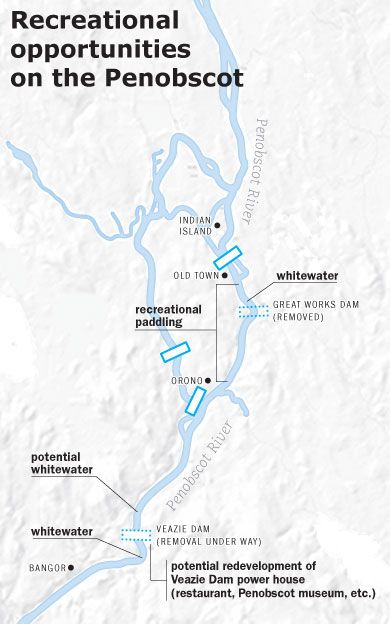
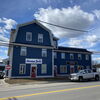





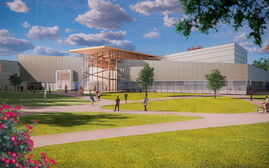
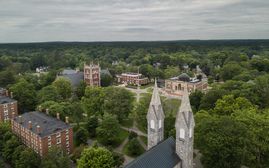
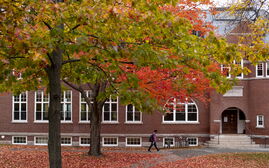





Comments